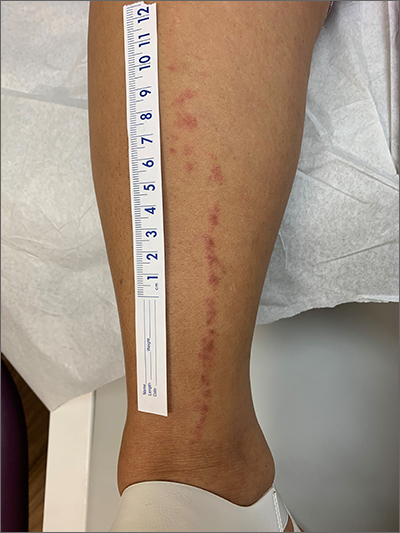
Jenny is a 42-year-old office manager who presents with a linear itchy rash on the abdomen and left calf.
She noticed this just as she was boarding the plane back to Australia after a three-week holiday in Europe.
The flight was uncomfortable because of the intense pruritus. Her husband has similar lesions on his legs.
Jenny is generally well, with no past or dermatological history of note. On examination she appears well, is afebrile, and has 2-5mm wheals, in a linear distribution on the calf(pictured) and similar appearing lesions on the left calf.
There is a small punctum visible at the centre of a number of these lesions. The cubital fossae, wrists and finger webs are spared.
What is the most likely diagnosis?
Correct!
Bed bugs are obligate, wingless, parasitic insects that infest human dwellings and feed on the blood of animal hosts, especially humans.
Characteristic skin manifestations may include a bite mark with visible punctum, and forming a pruritic linear rash, often in groups of three sometimes termed the ‘breakfast, lunch and dinner sign’. These may be evident within hours or several days of the bite. Less commonly, purpura, vesicles, pustules and hypersensitivity reactions may occur.
The two key species that affect humans are Cimex lectularius (common bed bug) and Cimex hemipterus (tropical bed bug). C. lectularius is predominantly found in temperate and subtropical regions, while C. hemipterus mainly occurs in the warmer subtropics and tropics, but has also recently been identified in Europe. Both species can coexist in localities such as Africa, Australia, Florida, Hawaii and Taiwan.
While much attention has focused recently on case numbers rising in France, there has, in fact been a global resurgence of bed bugs in the past 20 years.
This has affected virtually every sector, including private homes, public accommodation, offices, healthcare facilities and mass transit. In 2022, approximately 9% of apartments in large US cities were estimated to have bed bugs.
The leading cause for the resurgence has been the development of insecticide resistance. Increased global travel has facilitated global dispersal of these resistant strains.
Bed bugs live in human habitats, often hiding in mattress seams, or between wooden parts of furniture frames. They tend to feed nocturnally, once or twice weekly. Their activity is reduced at lower temperatures and reports suggest they can survive up to a year without feeding, which may hamper eradication efforts.
Infestation control measures include non-chemical approaches (vacuuming, temperature extremes and exclusion) and insecticides, though efficacy is limited by resistance. Novel control measures under investigation include RNA interference, toxicant baits and systemic toxicants.
Bites typically require symptomatic measures only, if needed. Active treatment may be required for cases complicated by superinfection or hypersensitivity reactions
